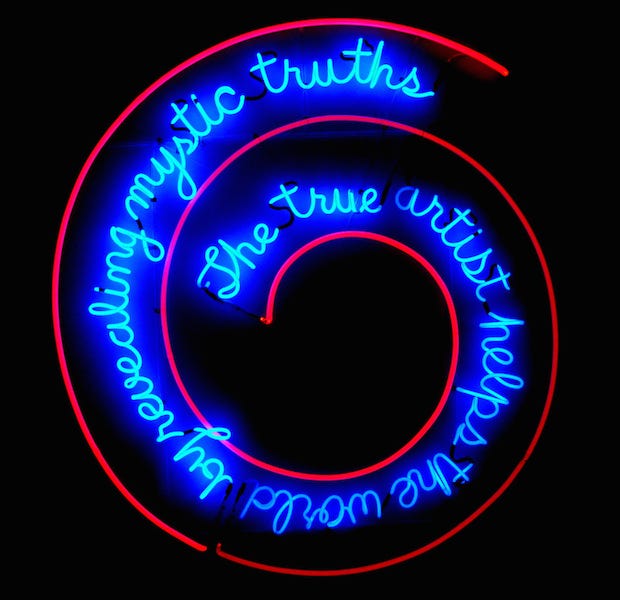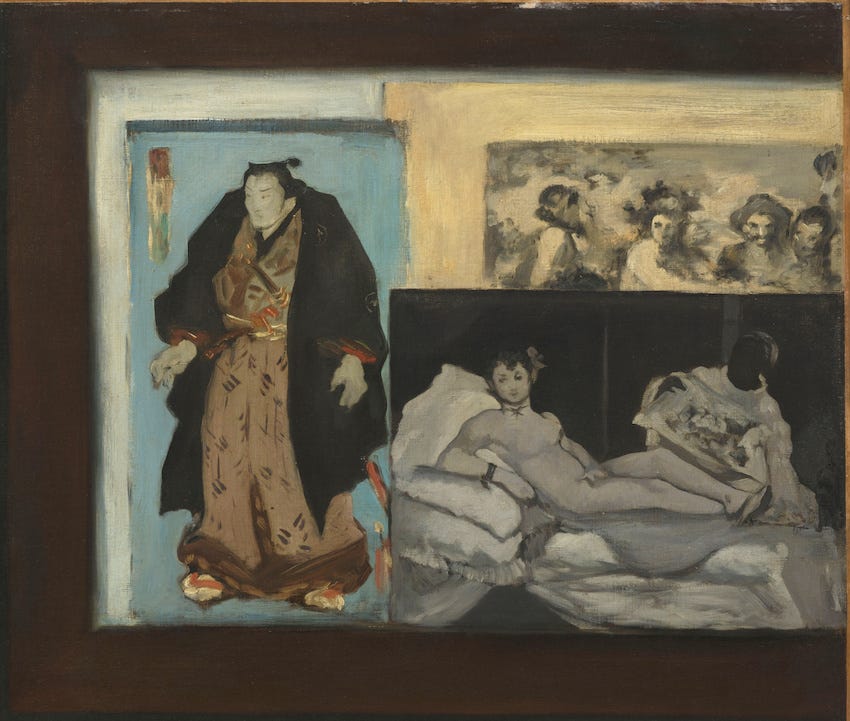Bruce Nauman, The True Artist Helps the World by Revealing Mystic Truths, 1967, neon and clear glass tubing suspension supports (photo: Giulia van Pelt)
I fly upwards of 100,000 miles every year—significantly more in non-pandemic years— but despite millions of lifetime miles flown, I’m still in perpetual awe of the miracle of air travel. As a humanities nerd, the aerodynamics at play are well beyond my elementary understanding of physics, but I can well imagine the precision required of all the machinery involved, particularly the navigation mechanisms. In fact, as I understand it, the Magnetic Direction Indicator (Compass) must be installed to careful specifications on each aircraft in order to ensure that it’s not affected by vibrations or magnetic fields, and then carefully tracked to ensure it is correctly calibrated, and even still, it must be recalibrated regularly. The recalibration is essential, otherwise — as we learned from those high school math problems — even if we are only a single degree off course when traveling from San Francisco to D.C., we’ll end up 40+ miles away from our destination, somewhere on the other side of Baltimore.
While I’ve never been partial to machine metaphors — they are limiting at best, problematic at worst — I do sometimes wonder if we’re more proactive in maintaining and caring for our machines than ourselves. If a compass requires recalibration after encountering vibrations, we’d be foolish to expect the human body (let alone, the human mind) – which are far more complex than a compass – to function properly without some ‘recalibration’ of its own. Yet, that is exactly what many of us do – working 14 plus-hour days, 7 days per week, neglecting our physical health, let alone our mental health – and ultimately paying a very high price for this neglect. If we pay attention to the signals early, it might feel as though we can recalibrate quickly and with relative ease – a long walk, a spa day, a nice vacation, or a new meditation practice, but what happens when our world has been upended and those traditional ‘quick fixes’ simply aren’t enough?
“You will burn and you will burn out; you will be healed and come back again.” - Fyodor Dostoevsky, The Brothers Karamazov
For me, more meaningful recalibration—or what I prefer to call ‘re-presencing’ in my life—requires three things:
(1) deep reflection on the past — who I believed myself to be at the last point of calibration, what I’ve been through and experienced since (the highs and lows), etc.
(2) an assessment of the impact — how have these experiences changed me, my beliefs, my positioning in and of this world, for better and for worse, and
(3) the opening up of exploratory space for what may lay ahead, in terms of challenges and opportunities, and how I would like to ‘show up’ in future contexts.
In April 2021, I found myself needing precisely this type of recalibration. I was newly vaccinated and coming out of months of lockdown that had upended my B.C. (before Covid) life of travel, adventure, an intense social calendar, and an even more intense workload, and while I was intending to return to all of the above, I also recognized that I’d first need to regain my bearings, physically but also emotionally. I’d need to not only get reacquainted with the old me and my old ways, but to make time and space to learn if and how I had changed during these strange months of lockdown, and if those old ways of being and my former interests and passions still suited the new me, whoever that was.
I embarked on several months of travel where I gradually and methodically reacquainted myself with familiar people and places I once loved, but also gave myself an extraordinary amount of space and solitude to explore these important questions. For every dinner with an old friend, there was a lunch with a new one, and four to five hours of solitude for simply being present to these questions and leaving space to answers (and in some cases, more questions) to surface.
The latter was predominantly spent in museums, large and small, all over the world. As I walked through the galleries, each holding a special place in my heart and my memory, I felt simultaneously anchored by the past and the experiences that had led me to this moment, but also the boundlessness of future potential — where I could go, what I could do/create, and even who I could be, depending upon which paths I might choose. I looked at each painting, not just with my eyes, but with my heart — closely observing my thoughts and reactions, and acutely noting any perceptible changes from previous encounters with the same works.
For example, when I encountered Emile Zola (1868) by Edouard Manet at the Musée d’Orsay — easily the 20th time we met over the years, if not more — I noted the same formal elements and iconographies that had always drawn me to this masterpiece. The Japanese screen that beautifully nods to the deep influence of Hokusai and other artists and artistic traditions from the Far East have had on contemporary Western painting (contemporary to Manet & Zola, that is), and also serves the functional purpose of providing perspective and framing the sitter—all the while obscuring other elements of the room (and perhaps metaphorically the sitter’s identity) that will not be included herein. The engraving of Velazquez’s Bacchus serving as an indicator for both the sitter and the painter’s affinity for Spanish art. The reproduction of Manet’s Olympia (1863), which had sparked a scandal and was fiercely defended by Zola, who believed it to be a masterpiece even if the Academy and Paris society wouldn’t recognize it as such. The desk, which seems to perfectly tow the line between cluttered and organized. And, Zola’s eyes, which look not down at the book that he’s reading, but off into the distance – perhaps reflecting on society, perhaps letting his imagination conjure up one of the many brilliant stories he would write, perhaps…we’ll never know. After allowing myself the time to take in all of these elements once again and feel their impact, individually and collectively, I’ll then open up space for looking anew – for seeing where my eyes, and my mind, might wander. This time, I thought deeply about the relationship between these two men — their friendship. The pandemic had tested many friendships and fortified new ones and I reflected on how my various friendships had weathered this pandemic.
Detail of Edouard Manet’s Emile Zola (1868), © RMN-Grand Palais (Musée d’Orsay)
When my eyes gradually shifted from the sitter to the reproduction of Manet’s Olympia in the upper right corner of the portrait, as I have done many times before given the indisputable importance of this work, my gaze and my heart fixated on the beautiful Black woman who brings flowers into the White woman’s bedchamber. I know her name was Laure, even though that important detail wasn’t imparted in art history lectures at university, and when I look at this painting that I love deeply, the woman I am today (or was on June 19, 2021 when I saw it most recently) can’t extricate the formal elements of this masterpiece from culpability in furthering anti-Blackness. With these thoughts weighing heavy on my heart as I look at this painting, I know that I’m not the same woman who last encountered it on July 2, 2019.
Photo by Hickey Robertson/The Rothko Chapel in Houston
Encounters with Mark Rothko, the extraordinary Abstract Expressionist – might provide a less iconographic illustration of this personal practice of re-presencing through art. Meditating in front of a Rothko – even the same Rothko – is never the same experience. The eye is drawn to different gradations of color, color fields may or may not levitate, and perhaps most importantly, the mind may stay dwelling on the formal aspects, or more likely it will wander to whatever weighs heavy on your soul at that moment. I learn so much about myself in those moments (and sometimes hours) spent in quiet meditation before a Rothko, and these encounters over the years have become ‘historical’ markers of my personal journey. I had similar (but different) experiences of Rothkos, Manets, and so many other masterpieces in museums in Chicago, Philadelphia, Rome, Prague and Amsterdam – and these encounters allowed me to do this deep, but important self-reflective work and ‘re-presence’ myself.
When I finally reached ‘home’ a few months later—nearly 9 months after I’d last been there—I was neither the same as when I’d left, nor a completely different person, but I could only know (or begin to know) how I had evolved because I had taken the time to reflect and recalibrate. I had successfully used the past as a reference point to reorient myself in the wake of upheaval, but then, and perhaps more importantly, released myself from expectations that I was the same woman — with the same desires, interests, and dreams —as before, and invited myself to step forward into the future without the weight of those past expectations, and to determine afresh which direction I’d like to move in next. For this is what recalibration truly offers us—it’s not just the opportunity to return to the status quo, but to chart a new course if we so desire, or to recommit to the old one with increased clarity and precision.







deep heart resonance! thank you Rebecca. as I am giving my thinking and cognitive mind a break at the moment, allowing the heart and felt sense to receive away from words, I reiterate, deep heart resonance! ... oops! it feels like something would like to be shared:
recalibration --> represencing ---> (and I add) integration --> (re)alignment